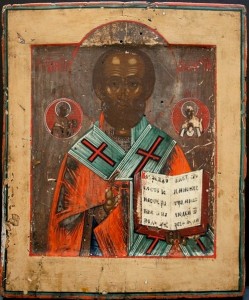GOOD MORNING P.O.U.! We hope you’re enjoying your weekend!
In light of the freak out racists had over a Black man portraying Santa Claus at The Mall of America in Minnesota, I thought it would be appropriate to repost this oldie, but goodie.
I know. I know. Santa Claus isn’t real. But a recent comment by POUer Annvic, in response to Megyn Kelly’s proclamation that Santa Claus is white, said something VERY interesting:
Oh, the arrogance of ignorant white people. Saint Nicholas (the man, the myth of Santa Claus was built on) *was* a black man and was always described and depicted as a black man in ancient religious artwork.
I wanted to learn more, so I got my Google on and found this Dec. 2002 article from The Turkish Times:
Santa Claus: How a Bearded Black Bishop Born in Turkey Became America’s Favorite White Saint
Linda Ann Loschiavo, Special to The Turkish Times – His beard and reputation are world famous. Miracles ascribed to him are legendary. Youngsters ponder his whereabouts and travel agenda, especially in December, knowing he’s not afraid to fly and he’s never run out of money.
Born to wealthy parents in Patara, Turkey, when the population of Anatolia was mostly pagan, it’s said he took a special interest in three sisters. Too poor to have dowries, they were being forced into prostitution when, suddenly, three bags of gold were thrown down their chimneys, enough bait to attract husbands. The trio did not leave thank you notes behind, for the record, but anyone with a bulging sack of benevolence is bound to be popular. Faith and hope, St. Paul wrote to the Corinthians, are outweighed: “The greatest of these is charity.”

Love for others is what always drove him, this Turk named Nicholas, which means “people’s victory.”
Devoted to good works, Saint Nicholas [270-310] was once Bishop of Myra (“Myrrh”), a town now called Demre. Anatolia, the territory of modern Turkey, has been the heartland of human civilization since 7,000 BC.
Patara, to the west of Demre, had been visited by St. Paul and St. Luke in 55 AD on their way from Miletus to Jerusalem; perhaps from this early date, a Christian community was established at this major Roman Lycian port. Demre, a vital port on a dangerous part of the Turkish coastline, became part of the pilgrimage route from Venice and Constantinople to the Holy Land [Palestine].
This helped spread the cult of the saint, especially for seafarers who once worshipped the pagan god Poseidon.
In 392, the Edict of Theodosius ruled that Christianity would be the state religion of the Empire. Large scale destruction of classical statues and temples began, and locals constructed houses of worship like the much restored church of St. Nicholas at Myra (Demre), whose foundations date back to the late 4th-5th centuries. Rocked by a religious seesaw, this church was enlarged by the Emperor Justinian in the 6th century, then destroyed in an Arab-Muslim raid in 1034, but rebuilt by Constantine IX in 1043.
During the Crusades, Catholic merchants sailed to Muslim countries to acquire relics for their own parishes. In May of 1087, several well-financed Italian groups were bidding on the bones of St. Nicholas when a boatload of Barese businessmen stole the remains and rowed them back to Apulia. The pugliese, about to lose to the wealthier Venetians, knew they would have a major tourist attraction if they grabbed San Nicola.

